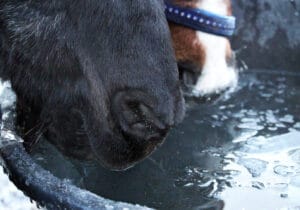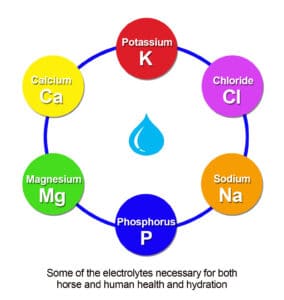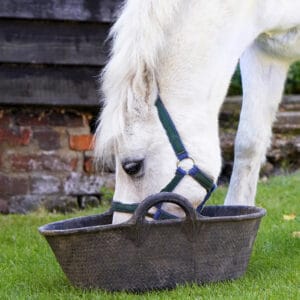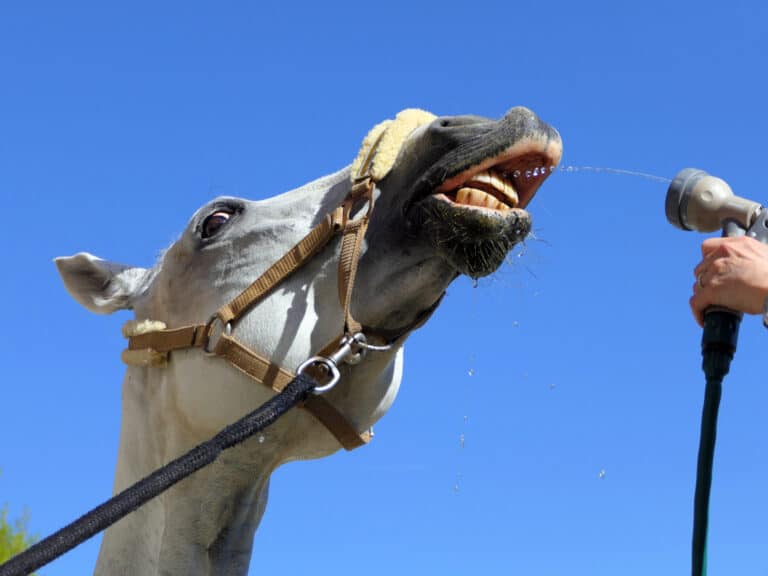When summer temperatures soar, ensuring your horse is properly hydrated is paramount. LEISA HOFSTETTER of Hof Equine Nutrition offers her expert advice on this important topic.
Hydration through the summer heat is extremely important in order to prevent dehydration and even death. But what does dehydration look like, and how can you prevent it? In order to keep their horse hydrated and healthy through the summer months, these are questions every horse owner should know how to answer.
If you suspect that your horse is dehydrated, you should call your vet immediately. Without treatment, dehydration can escalate quite quickly and can result in death. Signs of dehydration may include lethargy, stiffness, elevated heart rate, sunken eyes, dry mouth and nostrils, skin tenting, excessive or unusually limited sweating, and loss of appetite. To get a better idea of whether your horse is dehydrated, you can perform a skin tent test, check their heart rate and/or check their capillary refill rate.
Skin tent test
The skin tent test involves pinching the horse’s skin on the neck or shoulder into a ‘tent’, and observing the skin as it returns to its normal position. A well-hydrated horse’s skin should spring back into place almost immediately. A dehydrated horse’s skin tends to shrink back slowly, like water draining from a sink, and will wrinkle up as it does so. Although this does not confirm a diagnosis of dehydration, the skin tent test is a good indicator and you should seek veterinary advice as soon as possible.

Resting heart rate
An adult horse’s average resting heart rate is between 25 and 45 beats per minute. An elevated heart rate while the horse is at rest may be an indication of dehydration. To check your horse’s heart rate, locate their pulse. Some of the easiest locations to detect the pulse are at the back of the leg (digital) and at the facial artery. To find the digital pulse (the pulse that can be felt as blood flows through the artery into a horse’s hoof), place two fingers at the back of a pastern, just below the fetlock joint and about one third of the width of the pastern, on the side closest to you. Apply a firm, even pressure with your fingers. If you’ve located the right spot, you should feel a pulse. But remember, the resting heart rate of a horse is much slower than a human heart rate, so be prepared to wait a few seconds before you feel anything.
To locate the facial artery, again using a firm and even pressure, place two fingers beneath the lower jaw bone to the inside of the cheek. You may need to feel around a bit before you can locate either the facial artery pulse or the digital pulse. Once you have located your horse’s pulse, you can count the number of pulses you feel within 60 seconds. This will be your horse’s heart rate in beats per minute. If you have a fidgety horse you can record the number of pulses you can feel in 15 seconds, and then multiply the result by four.
Capillary refill rate
The capillary refill rate is the time it takes for capillaries in the horse’s gums to return to a healthy pink colour after pressing them with your finger. A healthy, hydrated horse’s gums will return to their normal colour in up to two seconds. A refill time longer than this may indicate dehydration. To do this test, press your finger or thumb firmly against your horse’s upper gum above an incisor (a front tooth). Immediately after removing your finger or thumb, the area of the gum where you applied pressure will be pale, almost white. Observe how long it takes for the colour to return to a normal pink. It should take no more than two seconds.
Intravenous fluids
Severe dehydration may need to be treated with intravenous fluids, which must be administered by your vet. In some cases of mild dehydration, your horse may be successfully treated with electrolytes given orally. However, it is important to seek veterinary advice if you suspect your horse is dehydrated. As mentioned earlier, without the correct treatment, dehydration can escalate quite quickly and can result in death.
Electrolytes
Electrolytes are minerals with an electric charge that carry out important functions in your horse’s body. One of their functions, in horses as well as humans, is to regulate water in the body. In other words, electrolytes are the very thing your horse’s body uses to maintain water at the right levels. Some examples of electrolytes in both humans and horses include sodium, chloride, potassium, magnesium, phosphorus and calcium.
In the increased temperatures of summer, your horse will obviously tend to sweat more than they would in lower temperatures. If your horse is sweating more, it means a greater electrolyte loss and therefore an increased requirement for electrolytes. The amount of additional electrolytes you will need to feed your horse depends on the ambient temperature. For example, in ambient temperatures of 40° or above, daily electrolyte requirements in feed are doubled compared to what you might feed in milder temperatures. Horses in work during summer are especially susceptible to electrolyte loss from sweating, so it’s important to carefully monitor your horse’s hydration levels.
If your horse is currently sweating when you work them, they may have a greater need for salt and mineral (electrolyte) supplementation in their feed. This is because when the normal electrolyte levels in their blood are reduced through sweating, they only return to normal when salts and minerals are included in their diet.

Reduced desire to drink
Reduced electrolyte levels in the horse’s blood can be a big problem, because reduced levels actually lower the horse’s desire to drink. Electrolytes in the horse’s body must be balanced and in the right quantities in order for the horse to drink as much water as it needs to return the water level in their body to normal. Offering water to a dehydrated horse while their electrolyte levels are low may dehydrate the horse even further. So if a horse is sweating during exercise, or due to increased ambient temperatures, or both, electrolytes must be supplemented in their feed to prevent dehydration. Use caution though, as an oversupply of electrolytes can have an effect that’s the opposite of the desired result. Your equine nutritionist can advise you regarding the types and amounts of electrolytes you should feed your horse.

Clean water
In addition to supplementing your horse’s feed with electrolytes, and especially if you are doing so, it is important to make sure your horse always has access to clean, fresh water. If you suspect your horse is not drinking for some reason, you can record the amount of water they drink per day by filling a plastic bucket with a known amount, then marking the water line with permanent marker. After 24 hours, record the remaining volume of water and subtract that figure from the original volume to find out how much has been consumed.
It is important to separate the horse from their paddock mates, including other animals, so that only the horse in question is drinking from the water bucket. You must also make sure the bucket cannot be tipped over or stood in. If your horse has consumed little to no water in 24 hours, consult your vet.

The normal daily consumption of water for a horse is around 20 to 50 litres. However, the amount a horse drinks can vary between horses, as well as from day to day. Each horse is different, and it is important for you to know what is normal for your horse. By understanding the signs of dehydration and providing the right components in your horse’s diet, you can help to prevent dehydration. Be sure to provide clean, fresh water and consult your equine nutritionist about the correct levels of electrolytes to add to your horse’s feed. Then sit back and enjoy the summer.
If you’re feeling the need for some expert advice, hop over to www.hofequine.com and get in touch with Leisa.



